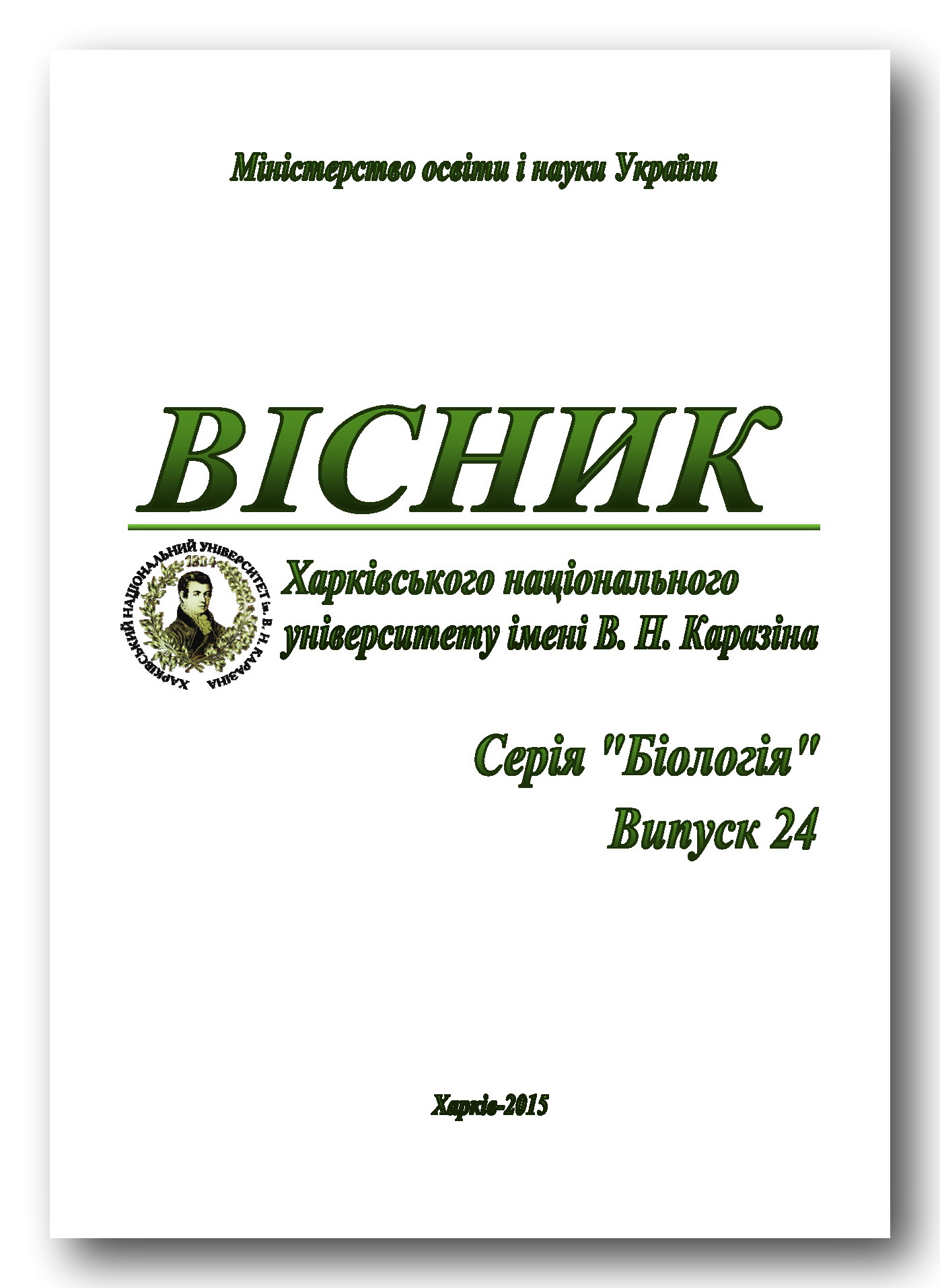The effect of low-dose cadmium chloride on erythrocyte resistance to lysis and prooxidant-antioxidant status of blood and spleen of rats
Abstract
Cadmium chloride at a single administration to rats in a dose of 0.6 mg/kg of body weight caused a decrease in erythrocyte resistance to hypotonic and iron-induced lysis, which was accompanied by a decrease of the catalase and arginase activity in erythrocytes and the accumulation of bilirubin in serum. CdCl2 treatment in a dose of 1 mcg/kg/day during 29 days resulted in an increase of reduced glutathione content in erythrocytes and maintenance of their osmotic resistance at the control level. The concentration of hemolysis products in blood serum and TBARS in erythrocytes decreased under CdCl2 action in a dose of 0,6 mg/kg, including chronic treatment by CdCl2 in a dose of 1 mcg/kg/day. No changes of heme oxygenase activity in liver and spleen as well as concentration of TBARS and urea in blood serum were revealed under cadmium chloride action.
Downloads
References
Стрельченко Е.В., Никитченко И.В., Калиман П.А. Гемоксигеназная активность в органах крыс при введении хлорида кадмия // Укр. біохім. журн. – 2002. – Т.74, №5. – С. 108–112. /Strel'chenko Ye.V., Nikitchenko I.V., Kaliman P.A. Gemoksigenaznaya aktivnost' v organakh krys pri vvedenii khlorida kadmiya // Ukr. bіokhіm. zhurn. – 2002. – T.74, №5. – S. 108–112./
Casalino E., Calzaretti G., Sblano C., Landriscina C. Molecular inhibitory mechanisms of antioxidant enzymes in rat liver and kidney by cadmium // Toxicology. – 2002. – Vol.179, N 1–2. – P. 37–50.
Dwivedi V.K., Bhatanagar A., Chaudhary M. Protective role of ceftriaxone plus sulbactam with VRP1034 on oxidative stress, hematological and enzymatic parameters in cadmium toxicity induced rat model // Interdiscip. Toxicol. – 2012. – Vol.5, N4. – P. 192–200.
Hamada T., Tanimoto A., Arima N. et al. Altered membrane skeleton of red blood cells participates in cadmium-induced anemia // Biochem. Mol. Biol. Int. – 1998. – Vol.45, N4. – P. 841–847.
Hammer Ø., Harper D.A. T., Ryan P.D. Past: Paleontological Statistics Software Package for education and data analysis // Palaeontologia Electronica. – 2001. – Vol.4, N1, art.4: 9pp.
Hrkal Z., Muller-Eberhard U. Partial characterization of the hemebinding serum glycoproteins rabbit and human hemopexin // Biochemistry. – 1971. – Vol.10. – P. 1746–1750.
Jain S.K. Hyperglycemia can cause membrane lipid peroxidation and osmotic fragility in human red blood cells // J. Biol. Chem. – 1989. – Vol.264, N35. – P. 21340–21345.
Kostic M.M., Ognjanovic B., Dimitrijevic S. et al. Cadmium-induced changes of antioxidant and metabolic status in red blood cells of rats: in vivo effects // Eur. J. Haematol. – 1993. – Vol.51, N2. – P. 86–92.
Macey R.I., Yousef L.W. Osmotic stability of red cells in renal circulation requires rapid urea transport // Am. J. Physiol. – 1988. – Vol.254, N5, Pt 1. – P. C669–C674.
Miller G. Protein determination for large number of samples // Anal. Chem. – 1959. – Vol.31, N5. − P. 964–966.
Morris C.R., Kato G.J., Poljakovic M. et al. Dysregulated arginine metabolism, hemolysis-associated pulmonary hypertension, and mortality in sickle cell disease // JAMA. – 2005. – Vol. 294, N1. – P. 81–90.
Mueller S., Riedel H.D., Stremmel W. Direct evidence for catalase as the predominant H2O2-removing enzyme in human erythrocytes // Blood. – 1997. – Vol.90, N12. – P. 4973–4978.
Ognjanovic B.I., Markovic S.D., Pavlovic S.Z. et al. Effect of chronic cadmium exposure on antioxidant defense system in some tissues of rats: protective effect of selenium // Physiol. Res. – 2008. – Vol.57, N3. – P. 403–411.
Ohkawa H. Assay for peroxides in animal tissues by thiobarbituric acid reaction // Anal. Biochem. – 1979. – Vol.95, N2. – Р. 351–358.
Omodeo-Sale F., Cortelezzi L., Vommaro Z. et al. Dysregulation of L-arginine metabolism and bioavailability associated to free plasma heme // Am. J. Physiol. Cell Physiol. – 2010. – Vol.299. – Р. 148–154.
Patterson J.W., Lazarow A. Determination of glutathione // Methods of Biochemical Analysis / Ed. D.Glick. – Interscience, 1955. – Vol.2. – P. 259–279.
Ramachandran B., Mäkelä S., Cravedi J.P. et al. Estrogen-like effects of diet-derived cadmium differ from those of orally administered CdCl2 in the ERE-luc estrogen reporter mouse model // Toxicol. Lett. – 2011. – Vol.202, N2. – P. 75–84.
Ryter S.W., Alam J., Choi A.M. Heme oxygenase-1/carbon monoxide: from basic science to therapeutic applications // Physiol. Rev. – 2006. – Vol.86, N2. – P. 583–650.
Sardana M.K., Sassa S., Kappas A. Hormonal regulation of heme oxygenase induction in avian hepatocyte culture // Biochem. Pharmacol. – 1985. – Vol.34, N16. – P. 2937–2944.
Sopjani M., Föller M., Dreischer P., Lang F. Stimulation of eryptosis by cadmium ions // Cell Physiol. Biochem. – 2008. – Vol.22, N 1–4. – P. 245–252.
Snyder L.M, Fortier N.L., Leb L. et al. The role of membrane protein sulfhydryl groups in hydrogen peroxide-mediated membrane damage in human erythrocytes // Biochim. Biophys. Acta. – 1988. – Vol.937, N2. – P. 229–240.
Stocker R., Glazert A.N., Ames B.N. Antioxidant activity of albumin-bound bilirubin // Proc. Natl. Acad. Sci. USA. – 1987. – Vol.84. – P. 5918–5922.
Swiergosz-Kowalewska R. Cadmium distribution and toxicity in tissues of small rodents // Microsc. Res. Tech. – 2001. – Vol.55, N3. – P. 208–222.
Woollard K.J., Sturgeon S., Chin-Dusting J.P. et al. Erythrocyte hemolysis and hemoglobin oxidation promote ferric chloride-induced vascular injury // J. Biol. Chem. – 2009. – Vol.284, N19. – P.13110–13118.
Authors retain copyright of their work and grant the journal the right of its first publication under the terms of the Creative Commons Attribution License 4.0 International (CC BY 4.0), that allows others to share the work with an acknowledgement of the work's authorship.




